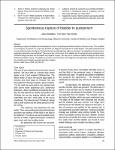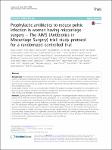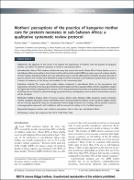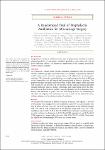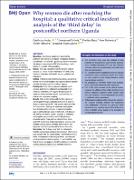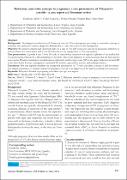Browsing Department of Obstetrics and gnaecology by Issue Date
Now showing items 1-11 of 11
-
Spontaneous rupture of bladder in puerperium
(African Health Sciences, 2004)Abstract Spontaneous rupture of bladder and extravasation of urine in the peritoneum without evidence of trauma is rare. This condition is an emergency. It presents in a unique way therefore, the diagnosis and treatment ... -
Prophylactic antibiotics to reduce pelvic infection in women having miscarriage surgery – The AIMS (Antibiotics in Miscarriage Surgery) trial: study protocol for a randomized controlled trial
(Trials, 2018)Abstract Background: The estimated annual global burden of miscarriage is 33 million out of 210 million pregnancies. Many women undergoing miscarriage have surgery to remove pregnancy tissues, resulting in miscarriage ... -
Mothers’ perceptions of the practice of kangaroo mother care for preterm neonates in sub-Saharan Africa: a qualitative systematic review protocol
(JBI Database of Systematic Reviews and Implementation Reports, 2019)Objective: The objective of this review is to explore the experiences of mothers with the practice of kangaroo mother care (KMC) for preterm neonates at home in sub-Saharan Africa. Introduction: About 7000 newborn babies ... -
A Randomized Trial of Prophylactic Antibiotics for Miscarriage Surgery
(The New England Journal of Medicine, 2019)BACKGROUND Surgical intervention is needed in some cases of spontaneous abortion to remove retained products of conception. Antibiotic prophylaxis may reduce the risk of pelvic infection, which is an important complication ... -
Obstetric Referrals to a Tertiary Hospital in Northern Uganda - A One Year Experience
(Jemds.com, 2020)BACKGROUND Delay in referral adversely affects maternal and neonatal outcome. We wanted to review the obstetric referrals, source of referrals, appropriateness of referrals and document the maternal and perinatal outcomes ... -
Why women die after reaching the hospital: a qualitative critical incident analysis of the ‘third delay’ in postconflict northern Uganda
(BMJ open, 2021)Objectives To critically explore and describe the pathways that women who require emergency obstetrics and newborn care (EmONC) go through and to understand the delays in accessing EmONC after reaching a health facility ... -
Refractory convulsive syncope in pregnancy: a rare presentation of Takayasu’s arteritis - a case report and literature review
(African Health Sciences, 2021-06-02)Background: Neurological manifestation of Takayasu’s Arteritis (TA) in pregnancy presenting as convulsive syncope is extremely rare, and poses a serious diagnostic dilemma due to other vast causes of fits in pregnancy. ... -
Gaps in available published data on abortion in Uganda and the missed opportunity to inform policy and practice
(International Journal of Gynecology & Obstetrics., 2022)Globally, 25% of pregnancies end up in induced abortion, the majority of which are unsafe. Abortion is safe when conducted according to WHO recommendations. The objective of the present study was to identify gaps in the ... -
Mothers’ perceptions of the practice of kangaroo mother care for preterm neonates in sub-Saharan Africa: a systematic review of qualitative evidence
(JBI Evidence Synthesis, 2022)Objective: The objective of this review was to explore the experiences of mothers with the practice of kangaroo mother care for preterm neonates at home in sub-Saharan Africa. Introduction: Newborn deaths globally have ... -
Estimating the Risk of Maternal Death at Admission: A Predictive Model from a 5-Year Case Reference Study in Northern Uganda
(Obstetrics and Gynecology International, 2022)Background. Uganda is one of the countries in the Sub-Saharan Africa with a very high maternal mortality ratio estimated at 336 deaths per 100,000 live births. We aimed at exploring the main factors affecting maternal ... -
Septic shock, acute renal and liver failure following unsafe abortion using bitter leaves and wandering jew in northern Uganda: A case series
(Clinical Case Reports, 2022)Unsafe abortion is a major problem in Uganda, being one of the leading causes of maternal morbidity and mortality. Abortions are performed mostly under unsafe conditions, by people without medical training. In rural areas ...

